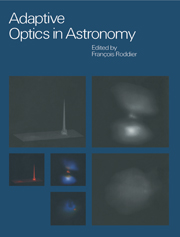Book contents
- Frontmatter
- Contents
- List of contributors
- Part one Introductory background
- 1 Historical context
- 2 Imaging through the atmosphere
- Part two The design of an adaptive optics system
- Part three Adaptive optics with natural guide stars
- Part four Adaptive optics with laser beacons
- Part five The impact of adaptive optics in astronomy
- Glossary of acronyms
- Index
2 - Imaging through the atmosphere
from Part one - Introductory background
Published online by Cambridge University Press: 23 November 2009
- Frontmatter
- Contents
- List of contributors
- Part one Introductory background
- 1 Historical context
- 2 Imaging through the atmosphere
- Part two The design of an adaptive optics system
- Part three Adaptive optics with natural guide stars
- Part four Adaptive optics with laser beacons
- Part five The impact of adaptive optics in astronomy
- Glossary of acronyms
- Index
Summary
The designing of an AO system requires a good appreciation of the characteristics of the wave-front aberrations that need to be compensated, and of their effect on image quality. Since these aberrations are random, they can only be described statistically, using statistical estimates such as variances, or covariances. These estimates define the so-called seeing conditions. We are dealing here with a non-stationary random process. Seeing conditions evolve with time. Therefore, one also needs to know the statistics of their evolution, mean value and standard deviation for a given telescope. A good knowledge of the seeing conditions during the observations is also important for the observing strategy. This chapter summarizes our knowledge on the statistics of the air refractive index fluctuations. From these, are derived the statistics of the wave-front distortions one seeks to compensate, and their effect on the intensity distribution in the image plane. A more detailed description of this material can be found in several review papers (Roddier 1981; Roddier 1989; Fried 1994).
Air refractive index fluctuations
Fluctuations in the air refractive index are essentially proportional to fluctuations in the air temperature. These are found at the interface between different air layers. Wind shears produce turbulence which mixes layers at different temperature, and therefore produces temperature inhomogeneities. The statistics of refractive index inhomogeneities follows that of temperature inhomogeneities, which are governed by the Kolmogorov–Obukhov law of turbulence.
- Type
- Chapter
- Information
- Adaptive Optics in Astronomy , pp. 9 - 22Publisher: Cambridge University PressPrint publication year: 1999
- 7
- Cited by

